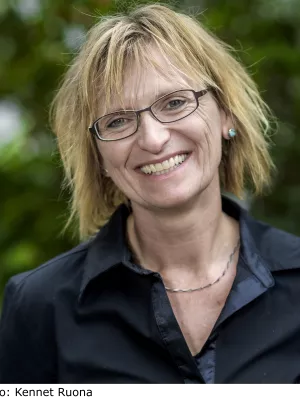
Natascha Kljun
Professor

Direct and indirect climate change effects on carbon dioxide fluxes in a thawing boreal forest–wetland landscape
Författare
Summary, in English
In the sporadic permafrost zone of northwestern Canada, boreal forest carbon dioxide (CO2) fluxes will be altered directly by climate change through changing meteorological forcing and indirectly through changes in landscape functioning associated with thaw‐induced collapse‐scar bog (‘wetland’) expansion. However, their combined effect on landscape‐scale net ecosystem CO2 exchange (NEELAND), resulting from changing gross primary productivity (GPP) and ecosystem respiration (ER), remains unknown. Here, we quantify indirect land cover change impacts on NEELAND and direct climate change impacts on modeled temperature‐ and light‐limited NEELAND of a boreal forest–wetland landscape. Using nested eddy covariance flux towers, we find both GPP and ER to be larger at the landscape compared to the wetland level. However, annual NEELAND (−20 g C m−2) and wetland NEE (−24 g C m−2) were similar, suggesting negligible wetland expansion effects on NEELAND. In contrast, we find non‐negligible direct climate change impacts when modeling NEELAND using projected air temperature and incoming shortwave radiation. At the end of the 21st century, modeled GPP mainly increases in spring and fall due to reduced temperature limitation, but becomes more frequently light‐limited in fall. In a warmer climate, ER increases year‐round in the absence of moisture stress resulting in net CO2 uptake increases in the shoulder seasons and decreases during the summer. Annually, landscape net CO2 uptake is projected to decline by 25 ± 14 g C m−2 for a moderate and 103 ± 38 g C m−2 for a high warming scenario, potentially reversing recently observed positive net CO2 uptake trends across the boreal biome. Thus, even without moisture stress, net CO2 uptake of boreal forest–wetland landscapes may decline, and ultimately, these landscapes may turn into net CO2 sources under continued anthropogenic CO2 emissions. We conclude that NEELAND changes are more likely to be driven by direct climate change rather than by indirect land cover change impacts.
Publiceringsår
2017-01-28
Språk
Engelska
Sidor
3231-3248
Publikation/Tidskrift/Serie
Global Change Biology
Volym
23
Issue
8
Dokumenttyp
Artikel i tidskrift
Förlag
Wiley-Blackwell
Ämne
- Climate Research
- Geophysics
Nyckelord
- climate change
- ecosystem respiration
- eddy covariance
- gross primary productivity
- permafrost
- wetlands
Status
Published
ISBN/ISSN/Övrigt
- ISSN: 1354-1013